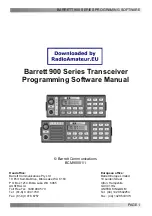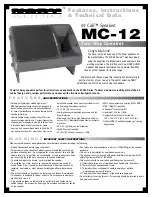
190-00734-11
GTX 33X and GTX 3X5 ADS-B Maintenance Manual
Rev. 6
Page 4-5
GTX 33/33D/335R/345R Visual Inspection
During normal aircraft inspections not to exceed 12 calendar month intervals, conduct a visual inspection
of the GTX 33/33D/335R/345R installation in the following locations.
Remote Mount Rack
1. Inspect GTX 33/33D/335R/345R units for security of attachment.
2. Inspect mounting rack and hardware for integrity.
a. Verify the racks, fasteners, and support structure are in good condition and are securely
fastened.
b. Inspect for signs of corrosion.
c. For composite aircraft, inspect any aluminum foil tape used to ground the GTX and verify that
it is not torn, damaged, or showing signs of corrosion. If any of these occur then the tape must
be replaced. Refer to appendix B for details.
3. Inspect any bonding straps for corrosion, loose connections, or signs of damage. Refer to appendix
4. Inspect the condition of the wiring harnesses and coaxial cables.
a. Verify that all wiring and cables are securely fastened.
b. Verify that the harness shows no signs of cracking, chaffing, abrasion, melting, or any other
form of damage.
c. Inspect the GTX 33/33D/335R/345R connectors for corrosion or other defects. Check the
integrity of the shield block ground attachments to the harness connector assembly as well as
the integrity of the individual shields and their attachment.
Antenna Visual Inspection
During normal aircraft inspections not to exceed 12 calendar month intervals, conduct a visual inspection
of the transponder antennas for the following.
1. Erosion, cracks, dents, or broken antenna. If these conditions are present, antenna must be
replaced. Refer to antenna manufacturer’s replacement instructions for details.
2. If the attachment is not secure, re-work the installation and complete electrical bonding test
3. Condition of base seals. In the event the antenna seal shows sign of damage or decomposition, re-
seal and complete the electrical bonding test specified in section 4.6.
Post Lightning Strike Inspection
A post lightning strike inspection must be performed for a suspected or actual lightning strike to antennas
or any temperature sensor connected to the GTX unit. Inspect antenna or sensor and surrounding
installation to verify that structural damage has not occurred around the areas where lightning may have
attached. If there is visible sign of damage to the antenna or sensor, then it should be replaced.
Inspect the antenna coax connection to GTX unit, grounding hardware, bonding straps or tape, and
surrounding areas of the remotely mounted GTX to verify damage has not occurred. Repair any damaged
areas and components, then complete the electrical bonding test specified in section 4.6.
















































